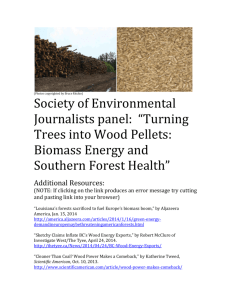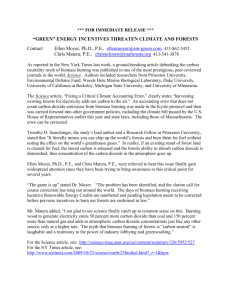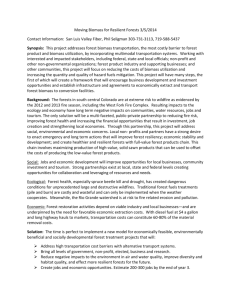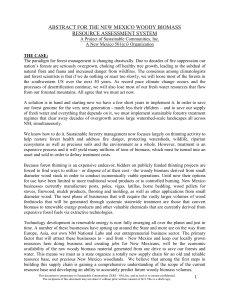Letter to Hon Dr Mike Kelly
advertisement
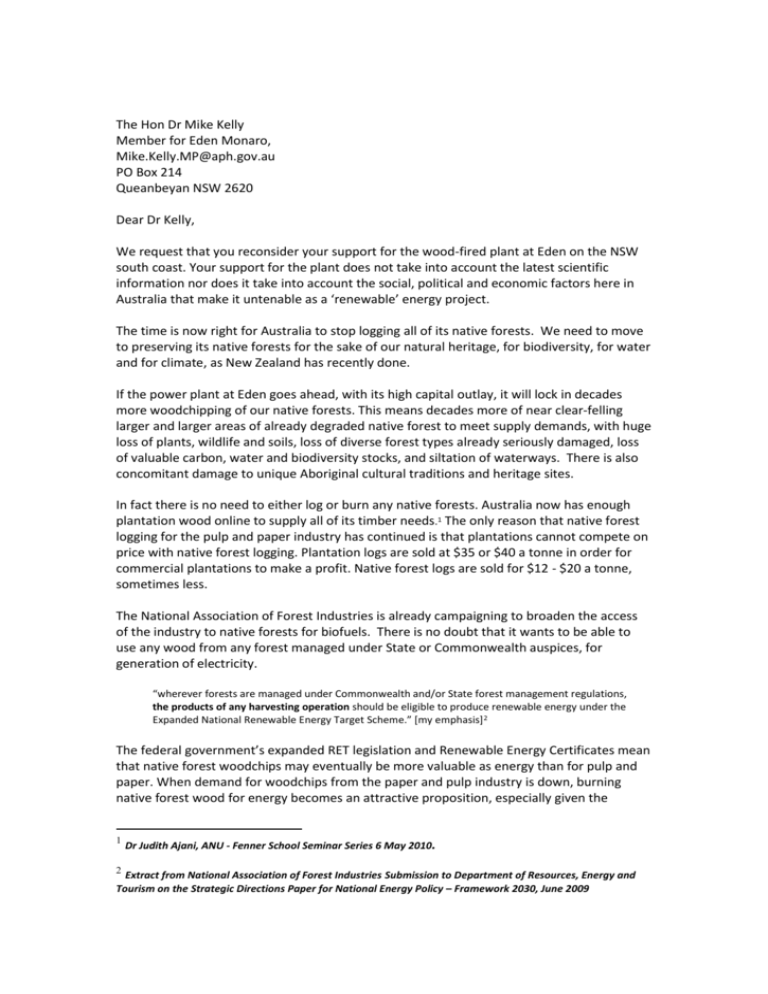
The Hon Dr Mike Kelly Member for Eden Monaro, Mike.Kelly.MP@aph.gov.au PO Box 214 Queanbeyan NSW 2620 Dear Dr Kelly, We request that you reconsider your support for the wood-fired plant at Eden on the NSW south coast. Your support for the plant does not take into account the latest scientific information nor does it take into account the social, political and economic factors here in Australia that make it untenable as a ‘renewable’ energy project. The time is now right for Australia to stop logging all of its native forests. We need to move to preserving its native forests for the sake of our natural heritage, for biodiversity, for water and for climate, as New Zealand has recently done. If the power plant at Eden goes ahead, with its high capital outlay, it will lock in decades more woodchipping of our native forests. This means decades more of near clear-felling larger and larger areas of already degraded native forest to meet supply demands, with huge loss of plants, wildlife and soils, loss of diverse forest types already seriously damaged, loss of valuable carbon, water and biodiversity stocks, and siltation of waterways. There is also concomitant damage to unique Aboriginal cultural traditions and heritage sites. In fact there is no need to either log or burn any native forests. Australia now has enough plantation wood online to supply all of its timber needs.1 The only reason that native forest logging for the pulp and paper industry has continued is that plantations cannot compete on price with native forest logging. Plantation logs are sold at $35 or $40 a tonne in order for commercial plantations to make a profit. Native forest logs are sold for $12 - $20 a tonne, sometimes less. The National Association of Forest Industries is already campaigning to broaden the access of the industry to native forests for biofuels. There is no doubt that it wants to be able to use any wood from any forest managed under State or Commonwealth auspices, for generation of electricity. “wherever forests are managed under Commonwealth and/or State forest management regulations, the products of any harvesting operation should be eligible to produce renewable energy under the Expanded National Renewable Energy Target Scheme.” [my emphasis] 2 The federal government’s expanded RET legislation and Renewable Energy Certificates mean that native forest woodchips may eventually be more valuable as energy than for pulp and paper. When demand for woodchips from the paper and pulp industry is down, burning native forest wood for energy becomes an attractive proposition, especially given the 1 2 Dr Judith Ajani, ANU - Fenner School Seminar Series 6 May 2010. Extract from National Association of Forest Industries Submission to Department of Resources, Energy and Tourism on the Strategic Directions Paper for National Energy Policy – Framework 2030, June 2009 inclusion of native forest biomass as a renewable energy source in the MRET. It is difficult to avoid the conclusion that companies that operate biomass power stations will structure the fluctuations of the market into their strategies, and make decisions about the use of forest resources accordingly. The logging industry has long used the rationale for logging that thinning and clearing of forests is actually healthy and that ‘cleaning’ up the ‘waste’ from logging for wood-fired power will make them healthier. However, the woody ‘waste’ products on the forest floor are essential for the maintenance of healthy soils. They encourage the growth of bacteria that healthy soils need. They also draw down CO2 into the earth. They also help store moisture in the soils and prevent them from drying out. A similar argument is used that clearing and thinning of forests prevent bushfires. In fact, thinning and removal of trees can increase the intensity of fires. Large-scale logging could increase bushfire risk for forests in south eastern Australia, creating bigger fuel loads and drier, more combustible conditions, new research says. A worldfirst study led by Australian National University fire ecologist Professor David Lindenmayer (2009) 3has found that gaps in the forest canopy allow the forest floor to dry out, increasing flammability by as much as 50 per cent in some cases. Overseas there is now fierce opposition in many places to the use of biomass for energy production. So concerned are some of the scientists in the US that a consortium of 90 leading US biologists and climate scientists recently sent a letter to the US House of Representatives expressing their concern over carbon accounting procedures. “clearing or cutting forests for energy, either to burn trees directly in power plants or to replace forests with bioenergy crops, has the net effect of releasing otherwise sequestered carbon into the atmosphere, just like the extraction and burning of fossil fuels. ….any legal measure to reduce greenhouse gas emissions must include a system to differentiate emissions from bioenergy based on the source of the biomass.” Community opposition to biomass plants is also growing. A number of biomass power projects planned in the US have been abandoned or postponed. In Massachusetts, officials have ordered a moratorium on new permits and commissioned a scientific review of the environmental credentials of biomass power. The US Manomet Biomass Sustainability and Carbon Policy Study (2010)4 found that using wood for energy results in a “carbon debt” because burning wood releases more CO2 into the atmosphere per unit of energy than fossil fuels (oil, coal, or natural gas). The study demonstrates that for, at least fifty years, burning wood to generate an equivalent amount of energy would create more emissions than burning coal. The American Lung Association has voiced serious concerns wood-fired power. “The health effects of ozone and particle pollution include wheezing, shortness of breath, increased risk of asthma attacks, pulmonary inflammation, and premature mortality.”5 3 http://www.abc.net.au/science/articles/2009/10/29/2726587.htm 4 http://www.manomet.org/node/322 5 http://floridiansagainstincineratorsindisguise.com/2009/12/15/american-lung-association-of-massachussetsvoices-concerns-over-biomass-power-plant/ Using the latest technologies is no guarantee that the health risks will be negated. The McNeil Biomass energy plant in Vermont, USA, features the latest pollution control technologies yet is the largest single source of air pollution in the state. The latest European study “Bioenergy: A Carbon Accounting Time Bomb (2010)6 concluded that “The carbon debt created when woody biomass is burned takes centuries to pay off. The result is that biomass can be more harmful to the climate than the fossil fuels it replaces.” The reason that native forest biomass can be considered a ‘renewable’ energy source by the Australian government is that the logging, burning and woodchipping of native forests that provide its fuel source is given a zero emissions value. This is misleading, as it is highly emissions intensive. The argument that the logging industry uses and the Commonwealth government supports is that since trees regrow they will re-sequester carbon released by burning biomass. However, carbon sequestration takes decades to centuries to fully bind – in the case of Australian native trees it takes 150-180 years for the trees and the ecosystems that support them to be re-established. The Australian logging industry works on 50 year rotations, in many cases 15-30 years, so the amount of carbon stored in regrowth can never equal the amount lost in logging and burning. By some accounts, biomass energy emits 4-6 times more carbon dioxide than burning coal. 7 Perhaps that is one reason why most of the electricity retailers in Australia do not want to touch it. Eleven retailers have come out and stated that they will not purchase RECs from the burning of native forest biomass. During the economic downturn the woodchip mill at Eden, NSW was unable to remain operation continually during 2009, and for many periods it was not operating. Yet it has made an application for a wood-fired power plant that it will operate 24/7 and provide ‘year round reliable supply of electricity’. If there are periods when there is no ‘waste’ to burn, it is difficult to understand how it could provide this reliable supply unless it plans to use sources other than milling and woodchip ‘waste’. We already know that it has promulgated the misinformation for decades that it only uses the ‘waste’ from milling operations for woodchips. It has only every used whole logs. Another argument that the logging industry uses for inclusion of wood fired power as renewable energy is based on the example of biomass power in parts of Europe such as Scandinavia, where it has been used for decades. As often happens, the European context is not suitable for Australia. In Europe there are no native forests which support the kinds of native ecosystems and biodiversity that Australian forests do, except in the very far north of Scandinavia. These forests are logged on 130 year rotations. Most forests in Europe are plantations, and even these are logged on much longer rotation times than in Australia (around 70 years). In comparison, Australian forests are logged on 50 year rotations, often 15-30 year rotations. 6 http://www.eeb.org/EEB/index.cfm?LinkServID=8481F382-A488-5532-533788C21A65D484&showMeta=0 7 http://www.johnkaye.org.au/media/adjournment-speech-eden-chipmill-and-green-power http://www.newwest.net/topic/article/biomass_energy_juggernaut_threatens_human_and_forest_health/C564/L 564/ There is a vast amount of agricultural waste in Europe which is used as biomass to fuel generators. With few exceptions this kind of fuel is not available in Australia in large quantities. In parts of Europe there are now huge problems with supply of biomass as fuel and Sweden has expressed interest in buying biomass fuel from Tasmania. These power plants are also problematic in their European environments, and they have their own emissions, odour and health problems. There may be a need for such plants in Europe, but with Australia’s ability to generate vast amounts of energy from solar, wind and geothermal, there is no need for these plants to be built here. There are only so many RECs issued, and allowing REC’s to be generated from native forest wood-fired power will reduce funding for genuinely renewable alternative energy supplies like solar, geothermal and wind power. Wood-fired power therefore deprives genuine renewables of much needed government subsidies. A recent initiative by Clean Energy for Eternity on the South Coast has generated over 50 jobs installing solar panelling on homes through the region, and has provided additional benefits of free solar power for community centres and schools. Isn’t this the kind of project that the NSW government should be supporting? The biomass plant at Eden will provide 6 full time jobs. Perhaps more than that will be lost to the tourist industry when the health risks and smell of the plant become apparent. It is difficult to see how this can be considered an important infrastructure project. Dr Kelly, these are all compelling reasons to reject the power plant at Eden. There is no point in approving this costly power plant when the science and the economics do not stack up. This plant will not be clean, green or renewable. We urge you to show real leadership on this issue and give this state a genuine clean energy future by rejecting this plant, and others like it. We are seeking a meeting with you as soon as possible to discuss this matter. Could you let us know when you are available to meet with us? Yours sincerely,
